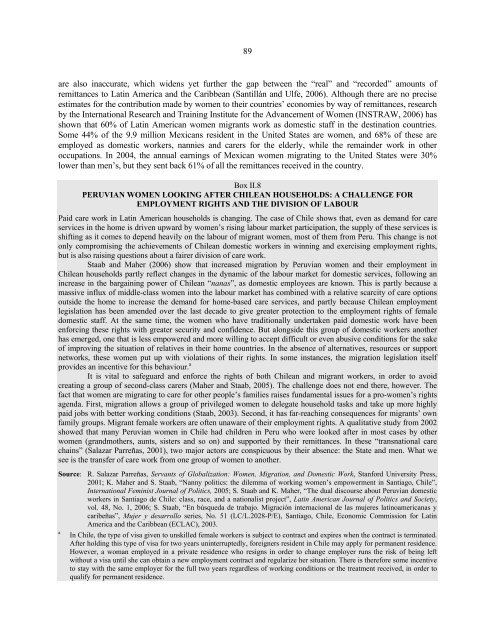Women in Latin America and the Caribbean - Cepal
Women in Latin America and the Caribbean - Cepal
Women in Latin America and the Caribbean - Cepal
Create successful ePaper yourself
Turn your PDF publications into a flip-book with our unique Google optimized e-Paper software.
89<br />
are also <strong>in</strong>accurate, which widens yet fur<strong>the</strong>r <strong>the</strong> gap between <strong>the</strong> “real” <strong>and</strong> “recorded” amounts of<br />
remittances to Lat<strong>in</strong> <strong>America</strong> <strong>and</strong> <strong>the</strong> <strong>Caribbean</strong> (Santillán <strong>and</strong> Ulfe, 2006). Although <strong>the</strong>re are no precise<br />
estimates for <strong>the</strong> contribution made by women to <strong>the</strong>ir countries’ economies by way of remittances, research<br />
by <strong>the</strong> International Research <strong>and</strong> Tra<strong>in</strong><strong>in</strong>g Institute for <strong>the</strong> Advancement of <strong>Women</strong> (INSTRAW, 2006) has<br />
shown that 60% of Lat<strong>in</strong> <strong>America</strong>n women migrants work as domestic staff <strong>in</strong> <strong>the</strong> dest<strong>in</strong>ation countries.<br />
Some 44% of <strong>the</strong> 9.9 million Mexicans resident <strong>in</strong> <strong>the</strong> United States are women, <strong>and</strong> 68% of <strong>the</strong>se are<br />
employed as domestic workers, nannies <strong>and</strong> carers for <strong>the</strong> elderly, while <strong>the</strong> rema<strong>in</strong>der work <strong>in</strong> o<strong>the</strong>r<br />
occupations. In 2004, <strong>the</strong> annual earn<strong>in</strong>gs of Mexican women migrat<strong>in</strong>g to <strong>the</strong> United States were 30%<br />
lower than men’s, but <strong>the</strong>y sent back 61% of all <strong>the</strong> remittances received <strong>in</strong> <strong>the</strong> country.<br />
Box II.8<br />
PERUVIAN WOMEN LOOKING AFTER CHILEAN HOUSEHOLDS: A CHALLENGE FOR<br />
EMPLOYMENT RIGHTS AND THE DIVISION OF LABOUR<br />
Paid care work <strong>in</strong> Lat<strong>in</strong> <strong>America</strong>n households is chang<strong>in</strong>g. The case of Chile shows that, even as dem<strong>and</strong> for care<br />
services <strong>in</strong> <strong>the</strong> home is driven upward by women’s ris<strong>in</strong>g labour market participation, <strong>the</strong> supply of <strong>the</strong>se services is<br />
shift<strong>in</strong>g as it comes to depend heavily on <strong>the</strong> labour of migrant women, most of <strong>the</strong>m from Peru. This change is not<br />
only compromis<strong>in</strong>g <strong>the</strong> achievements of Chilean domestic workers <strong>in</strong> w<strong>in</strong>n<strong>in</strong>g <strong>and</strong> exercis<strong>in</strong>g employment rights,<br />
but is also rais<strong>in</strong>g questions about a fairer division of care work.<br />
Staab <strong>and</strong> Maher (2006) show that <strong>in</strong>creased migration by Peruvian women <strong>and</strong> <strong>the</strong>ir employment <strong>in</strong><br />
Chilean households partly reflect changes <strong>in</strong> <strong>the</strong> dynamic of <strong>the</strong> labour market for domestic services, follow<strong>in</strong>g an<br />
<strong>in</strong>crease <strong>in</strong> <strong>the</strong> barga<strong>in</strong><strong>in</strong>g power of Chilean “nanas”, as domestic employees are known. This is partly because a<br />
massive <strong>in</strong>flux of middle-class women <strong>in</strong>to <strong>the</strong> labour market has comb<strong>in</strong>ed with a relative scarcity of care options<br />
outside <strong>the</strong> home to <strong>in</strong>crease <strong>the</strong> dem<strong>and</strong> for home-based care services, <strong>and</strong> partly because Chilean employment<br />
legislation has been amended over <strong>the</strong> last decade to give greater protection to <strong>the</strong> employment rights of female<br />
domestic staff. At <strong>the</strong> same time, <strong>the</strong> women who have traditionally undertaken paid domestic work have been<br />
enforc<strong>in</strong>g <strong>the</strong>se rights with greater security <strong>and</strong> confidence. But alongside this group of domestic workers ano<strong>the</strong>r<br />
has emerged, one that is less empowered <strong>and</strong> more will<strong>in</strong>g to accept difficult or even abusive conditions for <strong>the</strong> sake<br />
of improv<strong>in</strong>g <strong>the</strong> situation of relatives <strong>in</strong> <strong>the</strong>ir home countries. In <strong>the</strong> absence of alternatives, resources or support<br />
networks, <strong>the</strong>se women put up with violations of <strong>the</strong>ir rights. In some <strong>in</strong>stances, <strong>the</strong> migration legislation itself<br />
provides an <strong>in</strong>centive for this behaviour. a<br />
It is vital to safeguard <strong>and</strong> enforce <strong>the</strong> rights of both Chilean <strong>and</strong> migrant workers, <strong>in</strong> order to avoid<br />
creat<strong>in</strong>g a group of second-class carers (Maher <strong>and</strong> Staab, 2005). The challenge does not end <strong>the</strong>re, however. The<br />
fact that women are migrat<strong>in</strong>g to care for o<strong>the</strong>r people’s families raises fundamental issues for a pro-women’s rights<br />
agenda. First, migration allows a group of privileged women to delegate household tasks <strong>and</strong> take up more highly<br />
paid jobs with better work<strong>in</strong>g conditions (Staab, 2003). Second, it has far-reach<strong>in</strong>g consequences for migrants’ own<br />
family groups. Migrant female workers are often unaware of <strong>the</strong>ir employment rights. A qualitative study from 2002<br />
showed that many Peruvian women <strong>in</strong> Chile had children <strong>in</strong> Peru who were looked after <strong>in</strong> most cases by o<strong>the</strong>r<br />
women (gr<strong>and</strong>mo<strong>the</strong>rs, aunts, sisters <strong>and</strong> so on) <strong>and</strong> supported by <strong>the</strong>ir remittances. In <strong>the</strong>se “transnational care<br />
cha<strong>in</strong>s” (Salazar Parreñas, 2001), two major actors are conspicuous by <strong>the</strong>ir absence: <strong>the</strong> State <strong>and</strong> men. What we<br />
see is <strong>the</strong> transfer of care work from one group of women to ano<strong>the</strong>r.<br />
Source: R. Salazar Parreñas, Servants of Globalization: <strong>Women</strong>, Migration, <strong>and</strong> Domestic Work, Stanford University Press,<br />
2001; K. Maher <strong>and</strong> S. Staab, “Nanny politics: <strong>the</strong> dilemma of work<strong>in</strong>g women’s empowerment <strong>in</strong> Santiago, Chile”,<br />
International Fem<strong>in</strong>ist Journal of Politics, 2005; S. Staab <strong>and</strong> K. Maher, “The dual discourse about Peruvian domestic<br />
workers <strong>in</strong> Santiago de Chile: class, race, <strong>and</strong> a nationalist project”, Lat<strong>in</strong> <strong>America</strong>n Journal of Politics <strong>and</strong> Society,<br />
vol. 48, No. 1, 2006; S. Staab, “En búsqueda de trabajo. Migración <strong>in</strong>ternacional de las mujeres lat<strong>in</strong>oamericanas y<br />
caribeñas”, Mujer y desarrollo series, No. 51 (LC/L.2028-P/E), Santiago, Chile, Economic Commission for Lat<strong>in</strong><br />
<strong>America</strong> <strong>and</strong> <strong>the</strong> <strong>Caribbean</strong> (ECLAC), 2003.<br />
a<br />
In Chile, <strong>the</strong> type of visa given to unskilled female workers is subject to contract <strong>and</strong> expires when <strong>the</strong> contract is term<strong>in</strong>ated.<br />
After hold<strong>in</strong>g this type of visa for two years un<strong>in</strong>terruptedly, foreigners resident <strong>in</strong> Chile may apply for permanent residence.<br />
However, a woman employed <strong>in</strong> a private residence who resigns <strong>in</strong> order to change employer runs <strong>the</strong> risk of be<strong>in</strong>g left<br />
without a visa until she can obta<strong>in</strong> a new employment contract <strong>and</strong> regularize her situation. There is <strong>the</strong>refore some <strong>in</strong>centive<br />
to stay with <strong>the</strong> same employer for <strong>the</strong> full two years regardless of work<strong>in</strong>g conditions or <strong>the</strong> treatment received, <strong>in</strong> order to<br />
qualify for permanent residence.











